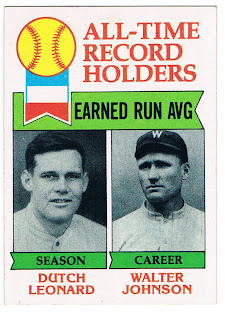With the end of another baseball season, another year's worth of statistics get added to the record books. Over the years, the record books go through a bunch of changes. However, even with specialized training and new advances, some records remain.
The 1979 Topps set had a subset that I have always found interesting. Cards #411-418 are titled "All Time Record Holders" and show black-and-white photos of the season and career leaders for eight of baseball's
major statistics. While 1979 was my first year of collecting, the cards introduced me to some of the great names of baseball's past and helped point me towards the vintage material I've followed for many years afterward. While it was neat to see the all-time record holders then, the passage of more than 30 years has meant some of the marks have fallen.
Card #411 shows the all-time hit leaders. Ty Cobb's career mark was passed by Pete Rose in 1985 and George Sisler's season mark from 1920 was broken in 2004 by Ichiro Suzuki. While both players shown were truly greats, the fact that progress has allowed players to stay healthy longer means that these records were destined to fall eventually. But the fact that Cobb's record stood for nearly 60 years and Sislers for more than 80 attests to their feats.
Card #412 has Hack Wilson and Hank Aaron, both of whom still hold these records. Wilson's 191 ribbies in 1930 may stand for a while...since the 1930s, only one player has come within even 25 RBIs away from that: Manny Ramirez in 1999. Among active players, Alex Rodriguez is more than 500 RBIs away from Aaron's all-time record and may have a shot at it if he stays healthy.
Card #413 has the Home Run leaders. Roger Maris is shown as the season leader, and Topps omitted the asterisk that MLB officially placed beside his name then. That mark was broken in 1998 by Mark McGwire and again in 2001, when Barry Bonds hit 73. Bonds also took Hank Aaron's place as career leader in 2007. Thanks to an era where many of the game's biggest hitters were accused of using steroids (McGwire admitted to it, Bonds has not but never tested positive either), these records are a source of constant debate among fans.
Card #414 shows batting average leader (since 1900, anyway). Rogers Hornsby with a .424 mark in 1924 and Ty Cobb with a career .367 mark; neither of those marks likely have any chance of falling.
Card #415 shows two pictures of Lou Brock. Brock was finishing up his Hall of Fame career that season but a rookie on the 1979 Oakland A's would eventually overtake both of Brock's marks. Rickey Henderson set the season mark in 1982 and broke Brock's career mark in 1991. Before finishing, he would end up with 1406 swipes. At the time the card came out, Brock hadn't yet claimed the "real" stolen base total; the back of the card correctly states that Billy Hamilton was the real leader but that he played under different rules. In any case, Brock would surpass Hamilton's total in '79 before retiring.
Some of the cards show performances that will stand the test of time. Card #416 shows the pitchers with the most wins. There is almost no chance of any modern pitcher breaking Cy Young's 511 lifetime wins, and
even less chance that any team's ace will win 41 in a single season like Jack Chesbro did in 1904. By the way, had Topps included pre-1900 records, Chesbro would actually be tied for 24th. Charley "Old Hoss" Radbourn won an astounding 59 games in 1884.
Card #417 shows the all-time strikeout leaders. Nolan Ryan is shown as the season leader, and his 383 K's in 1973 still stands as a record today. The career leader, Walter Johnson, was eclipsed in 1983 by Steve
Carlton (not even on the Top 10 all-time list shown on the back of this card only four years earlier) but Nolan Ryan ended his career with 5714. Johnson's record stood for over 50 years, but today he ranks ninth.
The last card in the subset shows the all-time ERA leaders since 1900. The back of the card has a couple of notations explaining that data was incomplete or missing for a couple of the pitchers for several years during the early 1900s. The card shows Leonard having a 1.01 ERA in 1914, but Baseball-Reference.com credits him with a phenomenal 0.96 for that year. As for Walter Johnson, he's listed as 12th all-time in the same place. Topps's metrics excluded all pre-1900 seasons and limited the list to pitchers with more than 3000 innings. That excluded BR's leader Ed Walsh, who pitched 2964.1 innings. However, among post-1900 pitchers with over 3000 innings, "Three Finger" Brown and Christy Mathewson both had better career ERA than Johnson. Perhaps the "missing" information from the early 1900s kept them off Topps' radar when they looked at the records.
Happy New Year!
-
I decided that New Year's Day was the perfect time to feature the first
card of the 1973 Topps set. That was back in 2011, and today is the first
day since...
11 years ago



%20Gift%20Order%20Form%20%5B587.77%208-12%5D.jpg)























Today, considering the fast life style that everyone is having, hop over to these guys credit cards have a huge demand in the economy. hop over to this site Persons from every area of life are using the credit card and people who are not using the credit cards have made up their minds to apply for even one. hop over to this website Thanks for discussing your ideas on credit cards. hop over to here
ReplyDelete